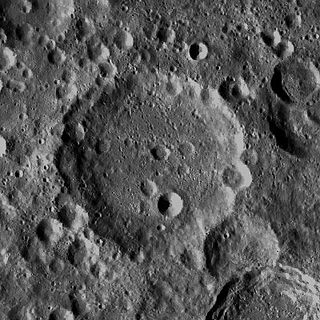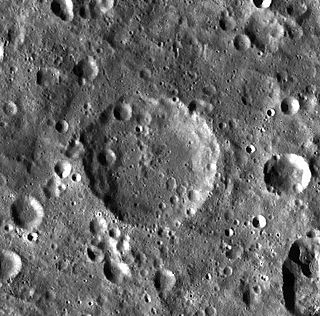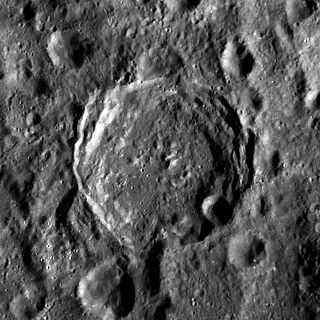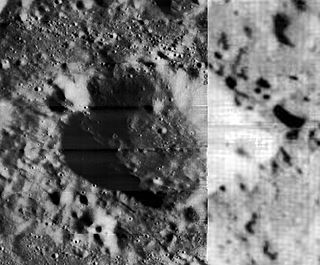 Lunar Orbiter 2 image | |
| Coordinates | 15°38′N176°44′E / 15.64°N 176.74°E Coordinates: 15°38′N176°44′E / 15.64°N 176.74°E |
|---|---|
| Diameter | 44 km |
| Depth | Unknown |
| Colongitude | 187° at sunrise |
| Eponym | Artturi I. Virtanen |

Virtanen is a lunar impact crater that is located to the northeast of the larger crater Sharonov, and to the east of Anderson. Virtanen lies on the far side of the Moon, and cannot be viewed directly from the Earth.

Lunar craters are impact craters on Earth's Moon. The Moon's surface has many craters, almost all of which were formed by impacts.

An impact crater is an approximately circular depression in the surface of a planet, moon, or other solid body in the Solar System or elsewhere, formed by the hypervelocity impact of a smaller body. In contrast to volcanic craters, which result from explosion or internal collapse, impact craters typically have raised rims and floors that are lower in elevation than the surrounding terrain. Impact craters range from small, simple, bowl-shaped depressions to large, complex, multi-ringed impact basins. Meteor Crater is a well-known example of a small impact crater on Earth.

Sharonov is a lunar impact crater that lies on the Moon's far side. It is located to the southeast of the crater Anderson, and to the southwest of the ray-covered Virtanen. To the south-southeast of Sharonov lies Valier.
This crater has a nearly circular rim, with a relatively narrow inner wall and a small rise near the interior midpoint. A small crater Virtanen F near the eastern rim lies at the focus of a small ray system that covers much of Virtanen and its surroundings. The rays are wispy in nature and somewhat asymmetrical, with the distribution being much more expansive to the west. At the origin of the rays is a bright patch of higher-albedo surface.

A ray system comprises radial streaks of fine ejecta thrown out during the formation of an impact crater, looking somewhat like many thin spokes coming from the hub of a wheel. The rays may extend for lengths up to several times the diameter of their originating crater, and are often accompanied by small secondary craters formed by larger chunks of ejecta. Ray systems have been identified on the Moon, Earth, Mercury, and some moons of the outer planets. Originally it was thought that they existed only on planets or moons lacking an atmosphere, but more recently they have been identified on Mars in infrared images taken from orbit by 2001 Mars Odyssey's thermal imager.

Albedo is the measure of the diffuse reflection of solar radiation out of the total solar radiation received by an astronomical body. It is dimensionless and measured on a scale from 0 to 1.
The crater lies within the Freundlich-Sharonov Basin.
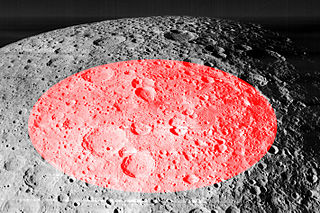
The Freundlich-Sharonov Basin is a Pre-Nectarian impact basin on the far side of the moon. It is named after the younger craters Freundlich near the northwest margin and Sharonov near the southwest margin. It lies east of Mare Moscoviense basin and northwest of Korolev basin.
